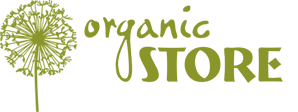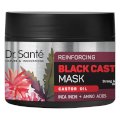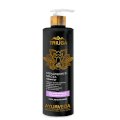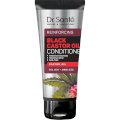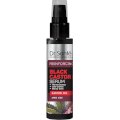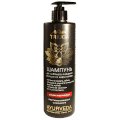 The modern beauty industry offers a huge variety of products designed to repair damaged hair. However, how do you figure out which of them are truly effective and which are well-marketed but mediocre? To answer this question, you need to thoroughly study their ingredient lists, looking for hair repair ingredients. Here are 4 active ingredients that are often found in products for damaged hair.
The modern beauty industry offers a huge variety of products designed to repair damaged hair. However, how do you figure out which of them are truly effective and which are well-marketed but mediocre? To answer this question, you need to thoroughly study their ingredient lists, looking for hair repair ingredients. Here are 4 active ingredients that are often found in products for damaged hair.
The hair shaft has a complex structure consisting of several layers. The outermost layer of the hair shaft, called the cuticle, consists of flat, thin cells, overlapping in layers like roof shingles. These cells form scales that protect the inner layers of the hair shaft (the cortex and the medulla). When the hair is healthy, the scales fit tightly together, forming a smooth shiny surface.
Harmful external factors, such as dry air or high temperatures, damage the cuticle scales, making them fit less snugly. As a result, the hair loses some of its natural protection and becomes brittle, less shiny and more unruly. Unruly hair gets tangled more easily, which not only makes it look unkempt, but also causes further damage.
The middle layer of the hair shaft is called the cortex. It is the thickest hair layer, consisting mainly of keratin (a structural protein responsible for the hair’s strength). It also contains most of the hair’s melanin (the pigment that gives the hair its colour). Having lost the protection of the cuticle, the cortex can also be damaged, resulting in the hair losing moisture and nutrients, and eventually breaking. And if nothing is done to rectify this situation, the hair will soon become straw-like.
Damaged hair needs an intensive care regimen that includes hair repair products. Today, most cosmetic brands produce entire collections of hair repair products, offering an impressive selection of shampoos, conditioners, masks, oils, and other products for damaged hair. But are these products really as effective as the manufacturers claim them to be?
It turns out, it’s all about the product composition. Really effective products for damaged hair are formulated with active ingredients that can fill the damaged parts of the hair shaft, provide the hair with moisture and nutrients, and protect it from further damage caused by harmful external factors. Here’s a list of four popular ingredients that can be found in most hair repair products.
Hydrolysed Keratin
As we’ve already mentioned above, keratin is a structural protein that makes up your hair. Of course, it seems quite logical that it is used to repair damaged hair structure. The word “hydrolysed” means that keratin has undergone a chemical reaction, resulting in it being broken into its component molecules. Hydrolysis makes it easier for keratin to repair the damaged hair parts.
However, it is worth noting that hair repair products with hydrolysed keratin should be used with caution, since its excess can be bad for your hair: with too much keratin, the hair becomes too heavy, which makes it break more often or even fall out. In addition, products with hydrolysed keratin might make your hair look greasy.
Hydrolysed Proteins
Hydrolysed proteins are the second popular group of active ingredients in hair repair products. On product labels, they are usually referred to as “hydrolysed * protein”, where * is the name of the protein source. Hydrolysed proteins can be derived from plants (for example, wheat, soy, corn, oats), silk, and wool (hydrolysed cashmere protein).
Hydrolysed proteins have the same effect on damaged hair as keratin, filling the damaged hair parts and restoring the natural strength, softness, gloss and volume of the hair. In addition, they make the hair easier to comb and style, protect it from further damage, reduce brittleness, and boost the hair’s elasticity and flexibility.
Amino Acids
Amino acids are the key elements of proteins, although not all amino acids are proteinogenic, i. e. incorporated into proteins. Technically, hydrolysed proteins are amino acids, too. Amino acids in hair repair products are responsible for restoring and strengthening the hair structure. In addition, they draw moisture to the hair and lock it in, boost hair elasticity, and make the hair smoother and more manageable.
Carrier Oils
Carrier oils, also known as vegetable oils or base oils, are among the most valuable cosmetic ingredients. Absolutely all carrier oils have a powerful nourishing and moisturising effect. In addition, they stimulate hair follicles, contributing to the growth of strong and healthy hair. Carrier oils are often found in hair repair products due to their protective and moisture retaining properties, thanks to which they protect the hair from further damage and moisture loss, reducing its brittleness.
Carrier oils with the most pronounced restorative effect include argan oil and macadamia oil. Argan oil is produced in Morocco, while the main exporter of macadamia oil is Australia. Both oils are relatively expensive, so some manufacturers rely on more affordable, but still effective alternatives, such as coconut oil, olive oil, linseed oil, sesame oil, and burdock root oil.
However, the mere fact that a product contains these ingredients doesn’t necessarily make it effective. High-quality products for the hair that has been damaged by dyeing, hot styling, perm, etc. must have a carefully balanced formula where all ingredients complement and enhance each other’s effect, working together to repair the hair and prevent further damage. That’s why you should choose hair care products offered by brands that have already earned the trust of customers.
In our online shop Organic Store, you can buy natural and organic products for damaged hair produced by trustworthy brands, such as Bio World, Cafe Mimi, Dr. Sante, Natura Siberica, Planeta Organica, Triuga, YAKA, and others. At Organic Store, we offer affordable prices, convenient payment methods, and international delivery to most parts of the world.
